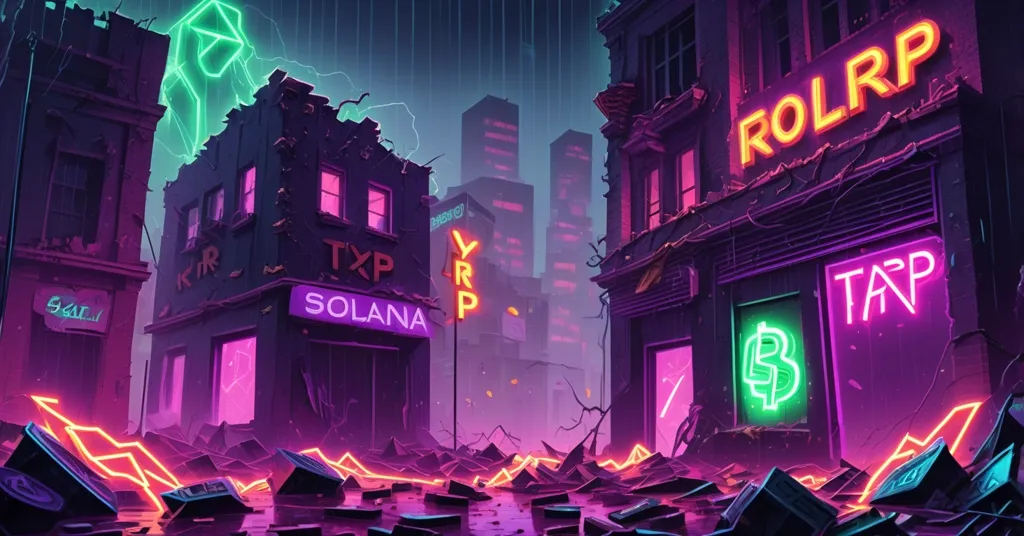SOL, XRP, Hedera Crash with Dead Cat Bounces as Digitap ($TAP) Presale Draws Risky Bets

SOL, XRP, and Hedera Flounder with Dead Cat Bounces as Digitap ($TAP) Lures Risk-Takers
October delivered a savage blow to the cryptocurrency market, with a catastrophic crash on the 10th erasing billions in value and leaving heavyweights like Solana (SOL), XRP, and Hedera (HBAR) staggering. While these tokens teased fleeting recoveries—classic “dead cat bounces”—they failed to hold ground amid crippling bearish sentiment. Meanwhile, a wildcard contender, Digitap ($TAP), is turning heads with its presale hype and bold “omni-bank” vision, drawing in “smart money” looking for a lifeline in this bloodbath.
- Market Meltdown: October 10th crash gutted crypto valuations, hammering SOL, XRP, and HBAR.
- False Recoveries: Brief price rebounds couldn’t sustain, exposing fragile investor confidence.
- Digitap’s Play: A hybrid banking-crypto project gains traction as a risky bear market bet.
The October Crypto Crash: A Brutal Wake-Up Call
The crypto market got a harsh reality check on October 10th, when a massive sell-off obliterated billions in market cap across the board. This wasn’t just a dip—it was a full-on nosedive, fueled by broader economic jitters like rising interest rates and geopolitical uncertainty. Bitcoin, the bedrock of the space, took a hit, but altcoins like Solana, XRP, and Hedera bore the brunt of the panic. Even now, weeks later, the aftershocks linger, with bearish sentiment dominating trading floors and social media alike. Bitcoin’s market dominance, hovering around 55% per CoinMarketCap data, underscores how investors are fleeing to the relative safety of the original cryptocurrency, leaving altcoins to bleed out. This macro backdrop—tightening monetary policy and a risk-off attitude in global markets—sets the stage for why even promising projects are struggling to regain footing in 2023’s unforgiving climate.
Solana (SOL): High Hopes, Crushed Momentum
Solana, a layer-1 blockchain celebrated for its lightning-fast transactions and scalability, couldn’t dodge the market’s wrath. For the uninitiated, a layer-1 blockchain is the base network where transactions are directly processed—think of it as the foundation of a digital economy. SOL’s price teased a recovery to $200 post-crash but slumped back to around $180, failing to smash through the $225 resistance level. Despite boasting a Total Value Locked (TVL) near an all-time high of $11 billion—imagine this as the total cash parked in Solana’s digital vault for staking and DeFi apps—the token couldn’t capitalize on its fundamentals. Per CoinGecko, trading volume dipped 30% after the bounce, signaling fading interest.
Bright spots emerged, like the launch of Solana ETFs in Hong Kong targeting non-crypto Asian investors and Western Union’s move to enable dollar-backed stablecoin transfers on the network. Yet, these catalysts fizzled out, unable to spark sustained buying. From a Bitcoin maximalist lens, I’ve got to point out Solana’s Achilles’ heel: its validator structure leans centralized, with a small number of nodes controlling much of the network. This sacrifices the pure decentralization Bitcoin champions for speed—a trade-off that’s useful for dApps but leaves purists like me skeptical. Still, upcoming upgrades like Firedancer, aimed at boosting scalability further, could be a game-changer if they deliver. For now, Solana’s price analysis screams caution: strong tech, weak market faith.
XRP: Billion-Dollar Deals, Zero Traction
XRP, the token tied to Ripple’s cross-border payment network, took an even uglier beating. Kicking off October above $3, it cratered below $2.50 by the 30th, with selling volume exploding to 400% of its daily average per CoinMarketCap stats. That’s not just a dip; that’s pure, unadulterated panic. Ripple, the company behind XRP, flexed serious muscle with a $1.25 billion acquisition of Hidden Road (now Ripple Prime) and a $1 billion buyout of GTreasury, pushing into broader financial services. Investors, though? They didn’t give a damn. The lack of price reaction suggests a deeper crisis of confidence—perhaps tied to XRP’s identity as a payment token or the lingering shadow of the SEC lawsuit in the U.S., which still questions whether XRP is a security.
Regulatory uncertainty isn’t just a buzzword here; it’s a sword over XRP’s head, especially as jurisdictions worldwide tighten crypto rules post-2022 disasters like FTX. Bitcoin maximalists like myself often criticize XRP’s corporate baggage—Ripple’s centralized control clashes with the ethos of censorship resistance. That said, I’ll concede XRP fills a niche for fast, cheap international transfers that Bitcoin doesn’t prioritize. Looking ahead, any positive development in the SEC case could flip the script, but for now, the XRP bear market vibe is deafening. If you’re holding, brace for more turbulence.
Hedera (HBAR): ETF Hype Falls Flat
Hedera, which runs on Hashgraph technology—a different beast from traditional blockchain, promising faster and more efficient transactions—also got clobbered. Its price slid from $0.215 to $0.16 after the crash, with a fleeting rally triggered by Canary Capital’s spot ETF announcement. If you’re new to this, a spot ETF lets investors track a crypto’s price without owning it directly, often hyped as a gateway to mainstream adoption. But when Hedera’s ETF debuted, it tanked with a 3.92% loss, mirrored by a similar drop in HBAR’s price. This “sell the news” phenomenon—where anticipation builds only to collapse post-event—laid bare the market’s skittishness.
Hashgraph’s tech edge over blockchain, with its focus on enterprise use cases, offers some long-term promise. Yet, Hedera’s centralized governance model draws flak from decentralization purists (guilty as charged). While Bitcoin remains my gold standard for freedom-focused tech, Hedera’s niche in scalable, business-friendly solutions can’t be ignored. Still, the ETF failure signals that no amount of institutional gloss can save a token when sentiment is this sour. Future partnerships or tech rollouts might shift the tide, but right now, HBAR holders are licking their wounds.
Dead Cat Bounce: False Hope in a Bear Market
Let’s unpack the “dead cat bounce” plaguing these tokens. Borrowed from traditional finance, it describes a short-lived price spike after a steep fall, tricking hopefuls into thinking the worst is over—only for gravity to kick back in. Picture a rubber ball hitting the ground hard: it bounces once, weakly, then rolls to a stop. That’s what SOL, XRP, and HBAR showed us in October—brief upticks post-crash, followed by renewed selling pressure. Historically, crypto has seen this before; think back to the 2018 bear market when altcoins like Litecoin spiked after crashes, only to plummet further as fundamentals failed to match hype.
This pattern isn’t just a quirk; it’s a psychological trap. Investors, desperate for green candles, pile in during rebounds, only to get burned when momentum fades. In today’s jittery climate, with macro headwinds like inflation and rate hikes spooking markets, these bounces are even less likely to stick. It’s a harsh lesson: sentiment often overpowers fundamentals in crypto’s chaotic arena. Are we in for a prolonged downturn, or is this just a shakeout before a bull run? Only time will tell, but don’t bet on quick miracles.
Digitap ($TAP): Underdog or Overhyped Gamble?
While established tokens flounder, a lesser-known player, Digitap ($TAP), is making waves in the shadows of this bear market. Positioning itself as an “omni-bank,” Digitap aims to fuse traditional banking with decentralized finance. Picture this: multi-currency IBANs for handling fiat like dollars or euros, crypto wallets supporting over 100 tokens, and a Visa-powered debit card hooked up to Apple Pay and Google Pay for seamless spending of both. It’s got a live app on iOS, Android, and web, plus an optional no-KYC signup—meaning you can skip handing over personal ID, a nod to privacy hawks but a potential red flag for regulators wary of money laundering. For context, KYC (Know Your Customer) is standard in finance to verify identities; dodging it appeals to crypto’s anarchist streak but often invites scrutiny.
The $TAP token presale started at $0.0125 in round one, climbed to $0.0268 by the third stage, and is slated for $0.0297 in the fourth round on November 5th. What began as weeks-long stages has shrunk to roughly a week each due to whale interest—big investors gobbling up supply. Audits by Solidproof and Coinsult, firms that check blockchain projects for security holes, add a layer of credibility in a space riddled with rug pulls. But let’s not get starry-eyed. Digitap’s roadmap beyond the presale is murky—no clear revenue model or post-launch adoption plan is widely public. Its team background, if public, remains under-discussed, and comparisons to past hybrid flops like Celsius—which promised banking-crypto integration before collapsing in 2022—raise valid concerns. Regulatory hurdles for no-KYC platforms are another looming storm cloud. Is this a genuine disruptor or just another presale fad destined to ghost investors? The jury’s out. For more insights on the buzz around Digitap ($TAP) and its presale traction, the space is watching closely.
Bitcoin’s Lens: Maximalism Meets Market Reality
As a Bitcoin maximalist, I can’t help but view this chaos through the lens of decentralization and freedom—principles Bitcoin embodies like no other. Solana’s speed comes at the cost of centralized validators; XRP’s corporate ties to Ripple clash with crypto’s anti-establishment roots; Hedera’s governance isn’t much better. Digitap’s hybrid pitch might onboard normies scared of pure crypto, but over-ambition in this space often ends in disaster—look at countless 2021 ICOs that promised the moon and delivered dust. Bitcoin, with its unyielding focus on censorship resistance and store of value, remains my north star. Why chase speculative altcoins or unproven presales when you can stack sats during these dips?
That said, I’m not blind to altcoin utility. Solana’s scalability powers DeFi apps Bitcoin can’t match; XRP’s payment rails target a real-world need; Hedera’s enterprise focus could carve a niche. Digitap, if it survives regulatory gauntlets, might bridge fiat and crypto for the masses—though I’d bet against it lasting without serious compromises. Bear markets like this one expose weaknesses but also drive desperate bets on high-risk, high-reward plays. Investors fleeing bruised altcoins for presales like $TAP are chasing quick flips, not principles. Fine, if you’ve got steel nerves—but don’t cry when volatility bites back.
Key Takeaways and Burning Questions
- What sparked the downfall of Solana, XRP, and Hedera in October?
A devastating market crash on October 10th wiped out billions, and despite brief rebounds, persistent selling and weak sentiment—coupled with specific flops like Hedera’s ETF debut and XRP’s fading trust—crushed any lasting recovery. - What’s a “dead cat bounce” in the crypto world?
It’s a temporary price jump after a sharp decline, giving false hope of a turnaround before prices drop again, as seen with SOL, XRP, and HBAR this month—a classic trap for optimistic traders. - Why is Digitap ($TAP) gaining buzz during this downturn?
Its “omni-bank” model, blending fiat banking with crypto via an app, Visa debit card, and no-KYC option, plus a presale with escalating prices, draws investors hunting gains amid a bleak market. - Are presale projects like Digitap safer than established tokens?
Not by a long shot. While staged price hikes offer short-term upside, they’re wildly speculative, unproven, and prone to scams or failure—far riskier than battle-tested coins despite their current struggles. - How does bearish sentiment steer crypto investment choices?
Down markets push investors toward early-stage gambles like Digitap for outsized returns, while distrust in major tokens grows, even when fundamentals or news (like Ripple’s acquisitions) suggest otherwise. - Should I buy altcoins in a bear market like this?
Only with extreme caution. Altcoins can offer value if you spot undervalued tech or catalysts, but current sentiment and macro pressures mean most are bleeding—stacking Bitcoin might be the saner play for now.
Looking Ahead: Rough Roads and Hard Choices
The road forward looks bumpy. Solana’s Firedancer upgrade could bolster its tech edge, while Ripple’s legal battles with the SEC might yield a surprise win—or a crippling blow. Hedera’s enterprise partnerships could spark life if sentiment shifts, and Digitap’s post-presale execution will make or break its hype. But in crypto, promises are cheap, and true value is forged in fire. Bear markets like October’s strip away illusions, revealing what’s worth hodling and what’s just noise. So, stack Bitcoin during the carnage, roll the dice on Digitap’s presale, or nurse wounded altcoins? That’s your call—but question every damn narrative, even mine. Stay sharp; this space doesn’t forgive the naive.



